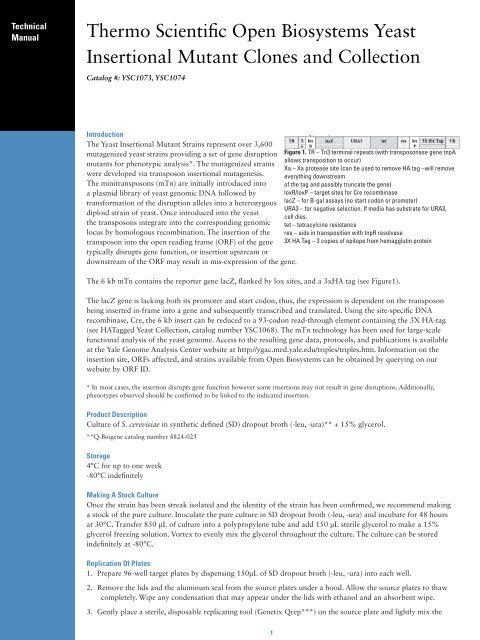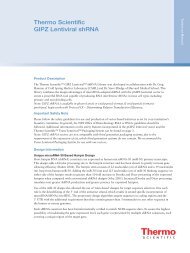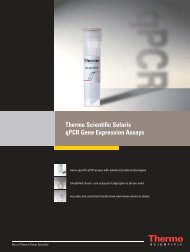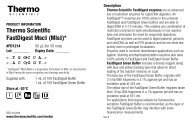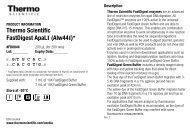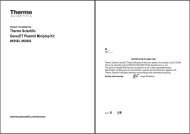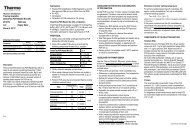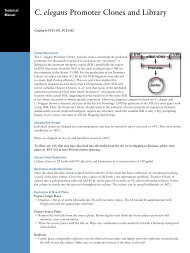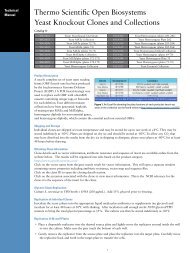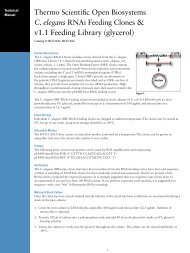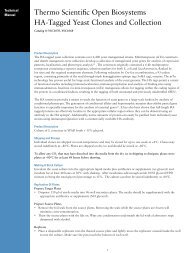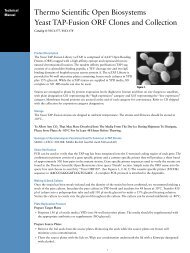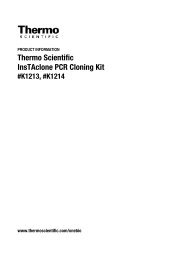Yeast Insertional Mutant Clones and Collection ... - Thermo Scientific
Yeast Insertional Mutant Clones and Collection ... - Thermo Scientific
Yeast Insertional Mutant Clones and Collection ... - Thermo Scientific
Create successful ePaper yourself
Turn your PDF publications into a flip-book with our unique Google optimized e-Paper software.
Technical<br />
Manual<br />
<strong>Thermo</strong> <strong>Scientific</strong> Open Biosystems <strong>Yeast</strong><br />
<strong>Insertional</strong> <strong>Mutant</strong> <strong>Clones</strong> <strong>and</strong> <strong>Collection</strong><br />
Catalog #: YSC1073, YSC1074<br />
Introduction<br />
The <strong>Yeast</strong> <strong>Insertional</strong> <strong>Mutant</strong> Strains represent over 3,600<br />
mutagenized yeast strains providing a set of gene disruption Figure 1. TR – Tn3 terminal repeats (with transposonase gene tnpA<br />
allows transposition to occur)<br />
mutants for phenotypic analysis*. The mutagenized strains<br />
Xa – Xa protease site (can be used to remove HA tag –will remove<br />
were developed via transposon insertional mutagenesis. everything downstream<br />
The minitransposons (mTn) are initially introduced into of the tag <strong>and</strong> possibly truncate the gene)<br />
a plasmid library of yeast genomic DNA followed by loxR/loxP – target sites for Cre recombinase<br />
transformation of the disruption alleles into a heterozygous lacZ – for B-gal assays (no start codon or promoter)<br />
URA3 – for negative selection. If media has substrate for URA3,<br />
diploid strain of yeast. Once introduced into the yeast<br />
cell dies.<br />
the transposons integrate into the corresponding genomic tet – tetracylcine resistance<br />
locus by homologous recombination. The insertion of the res – aids in transposition with tnpR resolvase<br />
transposon into the open reading frame (ORF) of the gene 3X HA Tag – 3 copies of epitope from hemagglutin protein<br />
typically disrupts gene function, or insertion upstream or<br />
downstream of the ORF may result in mis-expression of the gene.<br />
The 6 kb mTn contains the reporter gene lacZ, flanked by lox sites, <strong>and</strong> a 3xHA tag (see Figure1).<br />
The lacZ gene is lacking both its promoter <strong>and</strong> start codon, thus, the expression is dependent on the transposon<br />
being inserted in-frame into a gene <strong>and</strong> subsequently transcribed <strong>and</strong> translated. Using the site-specific DNA<br />
recombinase, Cre, the 6 kb insert can be reduced to a 93-codon read-through element containing the 3X HA-tag<br />
(see HATagged <strong>Yeast</strong> <strong>Collection</strong>, catalog number YSC1068). The mTn technology has been used for large-scale<br />
functional analysis of the yeast genome. Access to the resulting gene data, protocols, <strong>and</strong> publications is available<br />
at the Yale Genome Analysis Center website at http://ygac.med.yale.edu/triples/triples.htm. Information on the<br />
insertion site, ORFs affected, <strong>and</strong> strains available from Open Biosystems can be obtained by querying on our<br />
website by ORF ID.<br />
* In most cases, the insertion disrupts gene function however some insertions may not result in gene disruptions. Additionally,<br />
phenotypes observed should be confirmed to be linked to the indicated insertion.<br />
Product Description<br />
Culture of S. cerevisiae in synthetic defined (SD) dropout broth (-leu, -ura)** + 15% glycerol.<br />
**Q-Biogene catalog number 4824-025<br />
Storage<br />
4°C for up to one week<br />
-80°C indefinitely<br />
Making A Stock Culture<br />
Once the strain has been streak isolated <strong>and</strong> the identity of the strain has been confirmed, we recommend making<br />
a stock of the pure culture. Inoculate the pure culture in SD dropout broth (-leu, -ura) <strong>and</strong> incubate for 48 hours<br />
at 30°C. Transfer 850 μL of culture into a polypropylene tube <strong>and</strong> add 150 μL sterile glycerol to make a 15%<br />
glycerol freezing solution. Vortex to evenly mix the glycerol throughout the culture. The culture can be stored<br />
indefinitely at -80°C.<br />
Replication Of Plates<br />
1. Prepare 96-well target plates by dispensing 150μL of SD dropout broth (-leu, -ura) into each well.<br />
2. Remove the lids <strong>and</strong> the aluminum seal from the source plates under a hood. Allow the source plates to thaw<br />
completely. Wipe any condensation that may appear under the lids with ethanol <strong>and</strong> an absorbent wipe.<br />
3. Gently place a sterile, disposable replicating tool (Genetix Qrep***) on the source plate <strong>and</strong> lightly mix the<br />
1
yeast cells. Make sure to scrape the bottom<br />
of each well thoroughly, ensuring maximum<br />
transfer of cells.<br />
4. Gently remove the replicating tool from the<br />
source plate <strong>and</strong> gently insert the tool into the<br />
target plate. Mix the replicating tool around in<br />
the target plate.<br />
5. Dispose of the plastic replicating tool.<br />
6. Replace the lid of the target plate <strong>and</strong> the source plate.<br />
7. Repeat steps 1 – 6 until all plates have been replicated.<br />
8. Return the source plates to the ultralow freezer. Do not seal the plates until they are completely frozen. This<br />
will help ensure that the plates do not become crosscontaminated.<br />
9. Place the target plates in a 30°C incubator for up to 48 hours.<br />
10. When sufficient growth has been noted in the target plates, add 65μL of a sterile 50/50 mixture of glycerol <strong>and</strong><br />
SD dropout broth (-leu, -ura) to each well <strong>and</strong> mix. This will bring the total glycerol percentage in each well<br />
to 15%.<br />
11. Place target plates in an ultralow freezer. Do not seal the plates until they are completely frozen. This will help<br />
ensure that the plates do not become crosscontaminated.<br />
***Genetix catalog number X5054<br />
Strain Verification<br />
A PCR reaction using one gene specific <strong>and</strong> one mTn specific primer should yield a product with a known size,<br />
since the mTn insertion site is unique for each strain.<br />
mTn sequence: NCBI GenBank accession U54828<br />
(http://www.ncbi.nlm.nih.gov/)<br />
References<br />
P. Ross-Macdonald, et al., Nature 402, 413 (1999).<br />
Kumar, A. et al., Methods Enzymol. 328. 550-574 (2000).<br />
Useful Websites<br />
Public access to the resulting gene data, protocols, <strong>and</strong><br />
publications is available at the Yale Genome Analysis Center<br />
http://ygac.med.yale.edu/triples/triples.htm<br />
National Center for Biotechnology Information (NCBI)<br />
http://www.ncbi.nlm.nih.gov/<br />
Kumar, A., Cheung, K.-H., Ross-Macdonald, P., Coelho, P.S.R., Miller, P., <strong>and</strong> Snyder, M. Nucleic Acids Res. 28, 81<br />
(2000).<br />
FAQS/Troubleshooting<br />
For answers to questions that are not addressed here, please email technical support at<br />
openbiosystems@thermofisher.com with your question, your sales order or purchase order number <strong>and</strong> the catalog<br />
number or clone ID of the construct or collection with which you are having trouble.<br />
3<br />
Contact Information<br />
Technical Support<br />
Tel: 1.888.412.2225<br />
Fax: 1.256.704.4849<br />
openbiosystems@<br />
thermofisher.com<br />
© 2009 <strong>Thermo</strong> Fisher<br />
<strong>Scientific</strong> Inc. All rights<br />
reserved. Trademarks<br />
are the property of their<br />
respective owners. All<br />
other trademarks are<br />
the property of <strong>Thermo</strong><br />
Fisher <strong>Scientific</strong> Inc.<br />
<strong>and</strong> its subsidiaries. For<br />
Research Use Only.


